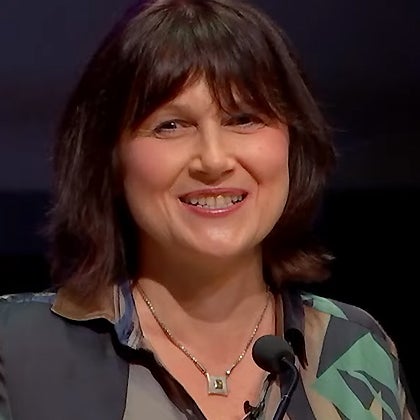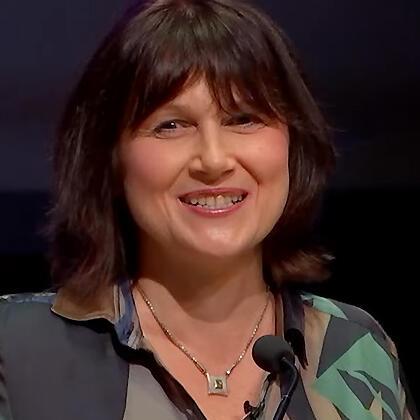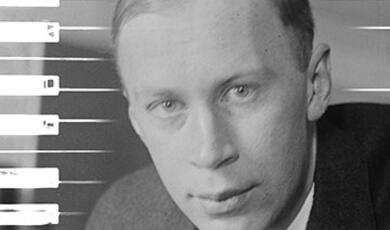Soviet Music in World War II
Share
- Details
- Transcript
- Audio
- Downloads
- Extra Reading
The tribulations of WWII (the “Great Patriotic War”) prompted a temporary liberalisation within Soviet culture. Images of horror and grief, formerly unacceptable, found their way into the wartime music of Soviet composers. The debate over Shostakovich’s Eighth Symphony showed how the boundaries of Socialist Realism could be stretched, but also where the limits lay.
The lecture will also discuss some works on Jewish themes (by Shostakovich, Weinberg and Gnessin) and their complex connection to the War and to the Holocaust.
Image © Zelma CC-BY-SA
Download Transcript
Soviet Music During World War II
Professor Marina Frolova-Walker
24th March 2022
Before 1941
In Soviet histories, the beginning of what we call World War II was rarely given much attention. For the Soviet Union, “The Great Patriotic War” only began on 22 June 1941, when Hitler’s tanks rolled over the border. This narrative was created to cover the events that with hindsight seemed shameful: the Molotov–Ribbentrop pact, the “Winter War” with Finland, and the advance into eastern Poland. Generations of Soviet citizens were raised on stories of the Great Patriotic War and had only a hazy conception of events during the previous two years.
Contemporary sources allow us to see how people reacted to these events. The pact between the Soviet Union and Nazi Germany was a huge shock for the population, which for years had been reading stern denunciations of the Nazi regime. At the same time, there was some relief that the apparently inevitable war had been averted, or at least postponed. When the War in the West began, there were mobilisations men of 18-years old and above, together with rising prices and shortages. The news of Soviet troops invading Poland was greeted with astonishment:
In Pravda today, one of the reports from western Ukraine styled the Poles as “the hateful enemy”. But it was only a month and a half ago that we were offering this “hateful enemy” our military help. Such is politics! Thankfully, people have short memories, and such word-spinning does not lodge in their conscious minds. (Diary of Alexander Gladkov, 27 September 1939)
The period of détente with Germany was marked by frequent performances of Wagner:
We listened to a radio broadcast of Die Walküre for Germany, with singers from the Bolshoi. It was prefaced with a speech by Sergei Eisenstein, who delivered it in German. He will be producing Die Walküre at the Bolshoi next season. It is known to be Hitler’s favourite opera, so this is a kind of political courtesy. In Berlin, they staged Ivan Susanin and published Quiet Flows the Don. (Diary of Alexander Gladkov, 18 February 1940)
Novels, plays, films and operas containing anti-German sentiment, previously encouraged, were now suddenly censored (including Eisenstein’s film Alexander Nevsky and Prokofiev’s opera Semyon Kotko).
Otherwise, the pressure on culture was relaxed as the regime shifted its attention to external affairs. Although Shostakovich’s Sixth Symphony was given a mixed reception, but any hostility was muted compared to 1936. Two major operas were released, and interestingly the sophistication of Prokofiev’s Semyon Kotko won greater support of the professional community than Khrennikov’s demotic Into the Storm. The number of honorary titles and medals given out to the “cultural workers” was always on the increase. The latest addition was the Stalin Prize, which brought the winners the fantastical sum of 100 000 roubles in addition to Soviet-wide prestige. The drab “Stalin cantatas” of the Socialist Realist mainstream were not, as we might imagine, the victors, but rather the much more demanding Piano Quintet of Shostakovich’s and Symphony No. 21 of Myaskovsky (neither had the “advantage” of any Soviet text or programme). These prizes were plainly awarded on an aesthetic basis, rather than an ideological basis.
Shostakovich’s Finnish Suite, however, provides a counterexample of sorts. As the Soviet Union went to war with Finland in November 1939, Shostakovich received a commission from the Political Office of the Leningrad Military Detachment for a suite of Finnish songs. It seems that this was an offer he couldn’t refuse, since meeting the deadline for the Suite forced him to miss the Moscow premiere of his Sixth Symphony. Stalin had expected the war to be a brief and victorious affair, with the aim of installing a friendly government under Otto Kuusinen within a few weeks, and the Suite would then have featured in the official celebrations. In the event, the campaign failed, and Shostakovich never made the work public (it was only brought to light after his death). The music is quite innocuous, but it witnesses to Shostakovich’s lack of freedom at the time (and the same can be said of any Soviet artist).
The License of War
And when the war broke out, its real horrors, its real dangers, the real menace of death, were a blessing compared with the inhuman power of the lie, a relief because it broke a spell of the dead letter.
Boris Pasternak, Doctor Zhivago
This view of the Great Patriotic War period is common to the thinking of many Soviet memoirists, who recalled the early 1940s as the “best” of times, even a “blessed” time. The memoirs refer to a wartime sense of freedom and fearlessness, and to an authentic and sincere patriotism. For the intelligentsia in particular, it was a time when they could identify wholeheartedly with their country and the war it was fighting. In the first year, the press called for individual initiative and heroism (initial resistance to the Germans fell to informal partisan units). Tragedy remained an inescapable part of Soviet life, but since the cause was external, it could now be discussed freely. Soviet art became increasingly humanised.
The coming of war provided Soviet composers and critics with a catch-all narrative: the magnitude of the event was such that every work written during the War and for some years afterwards was expected to reflect it in some way. Take Prokofiev’s Seventh Sonata, for example: its dissonance and rhythmic complexity would have been condemned before the War, but it now (supposedly) reflected the life-and-death struggle of the Soviet People. The so-called “grotesque” element in the styles of Prokofiev and Shostakovich, which was at odds with the aesthetic of Socialist Realism, could now be accepted as a mockery of Nazi-ism.
Shostakovich’s Seventh Symphony played a crucial role in validating the grotesque style within the war narrative, and also prompted other Soviet composers to return the symphonic genre as a suitable vehicle for wartime music of grandeur and depth. The Symphony’s first movement contains the unforgettable “invasion episode”, in which Shostakovich steadily builds up to an overwhelming and disturbing climax, all on the basis of the most unpromising material imaginable: an utterly trivial and banal little tune (reminiscent of an operetta known to be favoured by Hitler). The symphonies written under the influence of the Seventh were all distinguished for an evocation of horror and tragedy that was unprecedented in Socialist Realist music. Each of the major Soviet composers achieved this by his own means. Khachaturian, in his Second Symphony, repurposed his “national” idiom: the percussion patterns of music from the Caucasus, previously associated with fiery dances, contributed to the intensity of the tragic climax, while melodic patterns previously associated with oriental exoticism were redeployed in the service of a more universal lamentation. Prokofiev, in his Fifth Symphony, revisited music that had been discarded from his ballet Romeo and Juliet, which he used to create a scherzo as sinister as any in Shostakovich; the slow movement reaches an expressionist climax of great power. Previously, Prokofiev had come closest to such music in his opera of the supernatural, The Fiery Angel, which in the Soviet context counted as the most egregious of Western decadence, but such music could receive official approval as a portrayal of the horrors of war.
The real test case was Shostakovich’s Eighth Symphony (1943), which had all the seriousness and violence of a war-symphony, but where the message of the Seventh was clear, the Eighth deals in ambiguities. It is a difficult, uncompromising and lengthy work in five movements that tested the audience’s powers of concentration to the limits – even the great symphonist Myaskovsky admitted that it was not until the third listening that he could fully appreciate the piece. Perhaps most troubling was that in place of the expected rousing vision of the assured Soviet victory was a muted ending; we could say that the final mood was of quiet affirmation rather than resignation or despair, but this was hardly enough for the Symphony to meet with wholehearted official approval.
The Eighth sparked a lively debate in 1944, when it was considered for a Stalin Prize. Here are the opinions voiced by two fellow artists and a high-ranking official:
There are no purely musical faults in this work. Perhaps there are some longueurs, and perhaps the language is not laconic enough. It has extraordinarily powerful moments. In any case, this is a wonderful work from a musical point of view. […]
But there are, in my view, certain ideological shortcomings: there’s the fact that this work is extremely pessimistic. In our days, although we are going through much hardship, we still expect something that will rise above our painful experiences. But the Eighth Symphony gives the impression that it portrays with huge power all the darkness and pain that undoubtedly have a place in our experiences.
Alexander Goldenweiser, pianist
The Eighth, to me, is much more diverse [than the Seventh]. I would say that the two marches which follow one another [the second and third movements], make a colossal impression. The last movement seems over-expansive, and there are moments when you start to wonder “Is the end close?” – that is how much it tests your patience.
In my opinion, the Eighth Symphony is definitely not below the level of the Seventh. But there is one feature in Shostakovich’s music that is difficult for me personally: I can’t take it home with me after the concert. [. . .] Perhaps this is because of its fearsome complexity. But the impression is overwhelming. The Eighth Symphony is a huge work. There might be shortcomings, but those can be found anywhere. The two marches are quite exceptional…
Vera Mukhina, sculptor
On the last occasion, the musicians and a good many other comrades spoke positively of Shostakovich’s Eighth Symphony and evaluated it highly. As far as musical technique is concerned, it is likely that this work does indeed have great potential. But I am approaching the work as an ordinary listener. I listened to it three times, and gained the impression that in his Eighth Symphony, Shostakovich returns to themes that he had addressed earlier. Here we see, I think, an idiom that is deliberately complicated, and a kind of refinement that is not accessible to ordinary cultured listeners. This is the first point.
Secondly, it seems to me that this work is lacking in any kind of objective element, some broad public element that every large-scale symphonic work should possess. Shostakovich is speaking on his own behalf here, rather than on behalf of the many. His work is individualistic, or [at least] too individual. And finally, as other colleagues have already stated here, it is an extremely pessimistic work.
My feeling, as one who cannot be considered expert in music, is that we have here a piece that leads Shostakovich off from the path he had followed in the Quintet and the Seventh Symphony. … It is, I say again, a case of Shostakovich revisiting his past. I like Shostakovich very much, and value his talent very highly, and so it’s hard for me to say this, but I cannot refrain from doing so if I am to speak honestly.
Mikhail Khrapchenko, Chairman of the Committee for Arts Affairs
Deliberate over- complication and a lack of clear melody render the Symphony No. 8 incomprehensible to a wide layer of listeners. In this work, Shostakovich repeats the same formalist errors that had typified some of his earlier works.
Mikhail Khrapchenko in his letter to Stalin and Molotov
Caught between the high artistry of the Symphony and content that was inappropriate for the times, the Stalin Prize Committee reached a compromise and awarded Shostakovich a second-degree prize (in monetary terms, half the value of a first-degree prize). But because the country was still in the midst of war, there was no award ceremony, and the prize list was not finalised. At the end of the War, the nominations came before the Committee again. Shostakovich’s supporters saw their opportunity to remove the embarrassment of the second-class prize, and they reinforced their bid by adding the outstanding Piano Trio (No. 2) that Shostakovich had written in 1944. The minister Khrapchenko welcomed the proposal of the Trio, but instead of the awkward Eighth Symphony, not in addition to it. The Shostakovich camp insisted that the Symphony was a work of “extraordinarily high order”, but at this point, the direction of the discussion was changed abruptly by the architect Mordvinov. He began with an attack on another nomination, Mieczysław
Weinberg’s Quintet, but extended his criticisms to Shostakovich’s Trio, and also the Second Quartet (another wartime piece):
Some youth brings us a piece of utterly unbearable rubbish. [. . .] It is an outrageous thing, the most incredible cacophony, just a lot of caterwauling. There were some attempts at technical innovation: now you do it with a finger, now with a bow! We were laughing about it, that maybe he should get something attached to his back, so he could drum on it. How did this come about?
In this regard, I must raise an issue of principle here. The Stalin Prize Committee has a certain criterion of evaluation. It approaches every work from the point of view of Socialist Realism. If we were offered some kind of futurist daub as a painting, we would not even look at it. If we were offered some zaum’ [‘transrational’ poetry] in literature, we wouldn’t give it a hearing. So why in music do we have to listen to these formalist scams?
…
Some say, with regard to Shostakovich, that they understand nothing about music. But this music is supposed to be written for the masses. We heard Shostakovich’s [Second] Quartet. How does this differ from the Weinberg Quintet? Of course, one is a teacher, the other a pupil, but it’s unbearable cacophony [again], and it’s the most you can do just to stay put in your seat. And we keep saying Shostakovich is a genius, he’s a genius, a genius. We give it our encouragement. [. . .]
After this Quartet, this incredible chaos and cacophony, we heard some rounded phrases in the Trio, and people said that it’s very good. But if you take it by itself, there is nothing particularly good about it. People liked it because they heard it after the cacophony. I think we pay too much attention to Shostakovich, and by doing so, we open the way for formalism like this in the mainstream. They say that he’s won recognition in America. But how many leftist artists of various trends are recognized by English and American artists! That doesn’t mean for a moment that we should encourage this formalism. This is not the main line of development – it’s not the path along which music will develop. It will develop from the world’s classics, whereas this is just a diversion, pure technique.
When the Eighth Symphony is performed, there is a lot of cacophony there, but people hear something in it that reminds them of the cannons firing and the Katyusha rocket launchers squealing, while in the Quartet and the Trio this justification is lacking.
This attack from Mordvinov tipped the earlier balance between the aesthetic and the ideological; his discourse was of an aggressive and demagogical type that had been heard in the discussions of 1936. Mordvinov’s intervention caused subsequent speakers to express their support of Shostakovich with caution. Shostakovich’s bid for a prize could only be saved by jettisoning the Eighth Symphony from the proposal while accepting a second-degree prize for the Trio alone.
With hindsight, the Trio was never a strong contender for a prize. It was one of Shostakovich’s earliest pieces to adopt a Jewish musical idiom, and it is also a resolutely tragic piece. Just before Shostakovich began work on the Trio, the Soviet press uncovered Nazi atrocities committed in the prison camp at Majdanek, and it is likely (although not certain) that this was the inspiration for both these aspects of the Trio. Shostakovich was also influenced in several works by his Jewish pupils or followers such as Fleischman and Weinberg. As it turned out, the Jewish idioms were seen as welcome by the Committee, on purely musical grounds, as catchy foot-tapping material.
The story of the Eighth Symphony and its failure to win a prize proves that the greater artistic leeway offered by the war-narrative still had its limits. Once the tide turned after the German defeat at Stalingrad, victory was expected, and culture was gradually placed under tighter control again.
Celebrating the Victory
Shostakovich’s Seventh and Eighth Symphonies confirmed his role as a musical chronicler of the Soviet Union. When victory finally came in 1945, it was assumed that he would produce a monumental symphony of heroism and triumph, and the fact that it was to be his Ninth Symphony only reinforced the assumption. It seems that he did indeed start work on such a symphony, but he buckled under the strain of the expectations placed upon him. He abandoned the sketches, and switched his efforts to the composition of a short, neoclassical symphony bristling with cheeky tunes – a kind of “anti-Ninth”. Unfortunately for him, the Soviet news agency TASS advertised the forthcoming symphony as a “celebration of our great victory”. When the premiere came, Shostakovich’s defenders among the critics did their best to dispel the general reaction of consternation, claiming that the Symphony accurately expressed the Soviet people’s feelings of joy and relief after the end of the War. The detractors were able to present the new symphony as a brazen provocation by a composer with a chequered past. The Stalin Prize Committee still proposed to award the Symphony a second-degree prize, but the Politburo Commission was unimpressed:
The symphony is not of significant artistic value; it was performed in several concerts and public opinion held it to be a none-too-successful item within Shostakovich’s symphonic oeuvre. The symphony has not been widely performed, and it has not been heard anywhere for more than a year now.
If Shostakovich’s “victory celebration” was deemed too meagre, Prokofiev’s fell at the other extreme, of grandiosity. His Ode for the End of the War was scored for an astonishing eight harps, four pianos and an enormous band of woodwind, brass and percussion. Such extravagance seemed grotesque in itself, and in any case, the musical material was pitched too far from the mainstream of Socialist Realism (Prokofiev cheekily recycled a merry tune from his 1937 work, the Cantata for the 20th Anniversary of the October Revolution, which the officials had considered wholly inappropriate at the time).
In the end, no Soviet composer managed to produce a work that could be promoted officially as the “victory symphony”. The demand for such a piece soon waned, and even the new holiday of Victory Day was dropped as early as 1948 (although it was revived in the 1960s under Brezhnev and magnified in recent years under Putin). Stalin wanted the War to be forgotten: “liberated” POWs were sent to the Gulag, the archives were closed, and the streets of central Moscow were cleared of unsightly disabled veterans. Public expectations of liberalisation and international harmony after the War were shown to be delusory.
The Limits of Commemoration
The commemoration of the war-dead continued for decades as an approved topic in Soviet music, but it did not act as a guarantee. For example, when Yuri Levitin’s Seventh Quartet was discussed at the Stalin Prize Committee, members were perplexed by the dedication to a Ukrainian partisan girl, Elena Ubyivovk, who was had been executed by the Nazis. They questioned the presence of an episode representing the execution, as well as the use of particular Ukrainian folk songs for parts of the narrative. The work was rejected as “opportunistic” and “false”, even though Levitin was himself from Poltava, the city where Ubyivovk was born and died.
Another example of censored music of commemoration is Dmitri Klebanov’s 1945 symphony ‘for the martyrs of Babi Yar’, after the ravine in Kyiv where some 33,000 Jews were murdered by the Nazis. While wartime deaths in general could be commemorated in the Soviet Union, the specific commemoration of Jewish deaths was strongly discouraged, and it was not until the 1960s when Shostakovich’s Thirteenth Symphony (on verses by Yevtushenko) finally won grudging official acceptance. Klebanov’s Babi Yar Symphony was premiered in Kharkiv in 1946, but it was soon denounced as part of the “Anti-Cosmopolitanism Campaign” which was designed to remove Jews from prominent official and professional positions in Soviet society:
Grave mistakes have been found in the work of some composers. Thus, for example, the Kharkov composer D. Klebanov wrote a “Babi Yar” symphony that is steeped in the spirit of bourgeois nationalism and cosmopolitanism and founded on old Jewish religious songs. Rituals of ancient Palestine, “Israel’s Lament”, intonations of the synagogal chants – such are the sources which inspired Klebanov to create this antipatriotic symphony.
From a discussion at the Union of Composers in Kyiv in 1949
Klebanov’s career was badly damaged by the censure of his symphony. It is likely that Levitin’s work was rejected for related reasons, namely that it commemorated a Ukrainian victim of the Nazis in an expressly Ukrainian manner, including the use of old pre-Soviet Ukrainian songs. Accusations of “bourgeois nationalism” were soon routinely levelled at other Ukrainian artists, so Levitin may have been an early case, before the objection was fully articulated.
We end this lecture with the performance of another commemorative piece that succeeded in winning official acceptance at the time, but eventually acquired a new significance, as we shall see. This piece is a short single-movement Piano Trio by Mikhail Gnessin, bearing the dedication: “to the memory of our perished children”. Gnessin was a remarkable figure who cultivated his identity as a Jewish composer while still retaining a place the Soviet mainstream. In the 1920s, he was one of the pioneers of music on Soviet topics, while he was also a pioneer in efforts to create a Jewish national musical style. He displayed courage when he raised his voice against restrictions of composers’ freedom at several junctures (in 1931, 1936 and 1948), but he managed to keep his career intact, nevertheless.
The Trio was written during wartime evacuation, in Tashkent; upon his arrival, Gnessin discovered that his son Fabi, who had travelled to Tashkent earlier, had died, at the age of 35. The piece was intended as a commemoration of Fabi, but Gnessin decided to broaden the dedication, as he explained in the note that was distributed at the premiere:
The composer has strived to express our shared pain over our children, students, and young friends who perished in battles for our fatherland or who were tortured by the enemy in occupied cities; but he also seeks to stir up in his listeners’ memory an image of these young people as living beings, in their youth— from childhood dreams and play, from youthful unrequited love and aspirations, to the earliest real achievements of adulthood, and then their sudden deaths. The sections of the trio linked to the poetry of children’s sufferings are built on a theme . . . that was composed at age of eight by the son of the composer, Fabi, now deceased.
The idiom of the piece is also not explicitly Jewish, and although the melody of a Yiddish song is used, it is not easily identifiable as such. The style is Romantic and in keeping with the musical mainstream, so there was no obstacle to the performance of the work, which was published and widely heard. In more recent times, it has acquired a new meaning and status as Holocaust memorial music.
© Professor Frolova-Walker 2022
References and Further Reading
Marina Frolova-Walker, '"Music is Obscure": Textless Soviet works and their Phantom Programmes', Representation and Meaning in Western Music, ed. by Joshua S. Walden (Cambridge: Cambridge University Press, 2013), 47-63.
Marina Frolova-Walker, Stalin’s Music Prize: Soviet Culture and Politics (New Haven and London: Yale University Press, 2016).
Lyudmila Kovnatskaya, “Finskaya syuita Shostakovicha v leningradskom muzïkal’nom kontekste: istoriya rukopisi”, Opera Musicologica, No. 4 (2017), 19-34.
James Loeffler, “In Memory of Our Murdered (Jewish) Children”: Hearing the Holocaust in Soviet Jewish Culture, Slavic Review, Vol. 73, No. 3 (FALL 2014), 585-611.
https://prozhito.org [electronic resource that contains a collection of diaries]
References and Further Reading
Marina Frolova-Walker, '"Music is Obscure": Textless Soviet works and their Phantom Programmes', Representation and Meaning in Western Music, ed. by Joshua S. Walden (Cambridge: Cambridge University Press, 2013), 47-63.
Marina Frolova-Walker, Stalin’s Music Prize: Soviet Culture and Politics (New Haven and London: Yale University Press, 2016).
Lyudmila Kovnatskaya, “Finskaya syuita Shostakovicha v leningradskom muzïkal’nom kontekste: istoriya rukopisi”, Opera Musicologica, No. 4 (2017), 19-34.
James Loeffler, “In Memory of Our Murdered (Jewish) Children”: Hearing the Holocaust in Soviet Jewish Culture, Slavic Review, Vol. 73, No. 3 (FALL 2014), 585-611.
https://prozhito.org [electronic resource that contains a collection of diaries]
Part of:
This event was on Thu, 24 Mar 2022
Support Gresham
Gresham College has offered an outstanding education to the public free of charge for over 400 years. Today, Gresham plays an important role in fostering a love of learning and a greater understanding of ourselves and the world around us. Your donation will help to widen our reach and to broaden our audience, allowing more people to benefit from a high-quality education from some of the brightest minds.


 Login
Login







